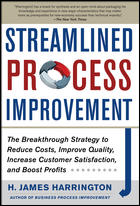The question of where to focus to maximize effectiveness is a conundrum.
Many organizations say “our people make us special.” Even if this isn’t truly reflective of their actions, it’s a sentiment that pushes organizations to focus on hiring the right kind of talent. Maybe the real focus should be on creating the right kinds of processes and structures to get the most out of whomever they bring in to operate within the processes.
The ultimate question remains: Should the focus be on improving processes or on recruiting, hiring and retaining the right people?
Peter Drucker, the late author and management consultant, wrote that “neither technology nor people determine the other, but each shapes the other.”
A colleague, in a previous career, was a manufacturing technology professor who knew little about the quality discipline. All he wanted was to improve his students’ exam scores, but his efforts at collaborative learning, student projects, and increased feedback were frustrating.
In retrospect, he realized he was too busy introducing activities that only confounded his students’ learning. This resulted in taking time away from fully engaging students. He tampered with his new approach but ended up blaming the students and himself for falling short of the desired outcome. This experience greatly influenced his thoughts regarding quality.
Feeling frustrated he left his teaching position to start a new career. His first exposure to quality principles occurred in his role as a data analyst in the reliability group of a large industrial company. Responsibilities of the group included the production of reports tabulating numbers associated with product quality and warranty claims.
The true extent of data quality issues was difficult to determine because several groups inside and outside the company played a role in claim data definition and input. In planning how to evaluate claim data quality, building a framework of systems-thinking proved extremely helpful. Namely, the process principles of statistical thinking formed the conceptual foundation of a quality improvement plan which included: (1) All work occurs in a system of interconnected processes; (2) Variation exists in all processes; and (3) Understanding and reducing variation are keys to success.
Following these quality principles, his group recommended data audits occur regularly on the entire claim process flow to assess data quality and identify the root causes of errors.
His group was disappointed to learn that key managers were unreceptive to the audit proposal. During one meeting in which the proposed audit was presented, the department director said, “We don’t want to make others look bad.” This illustrated a challenge to the process perspective. The director’s viewpoint of the root causes of the data problems emphasized the accountability of people over process.
This view of individual accountability is not uncommon. In another organization, a company announced the formation of a new department that would oversee a major initiative. When the new director was asked how cooperation would be ensured between existing departments and the newly formed group, the director said, “Personnel is policy and overrides everything else.”
Accounting for these views, a translation from process to a greater attention on people suggests the following principles: (1) All work is done by individuals; (2) An individual’s work is variable; (3) Key to quality improvement is reducing variation by getting the right person into the right job.
For most quality professionals, focus on people over process is exactly the opposite approach to quality improvement as Dr. W. Edward Deming’s parable of the red beads. Deming’s message is individuals work in systems beyond their control. It is the system—not individuals’ skills—that determines how the individuals perform!
So where does this leave a quality practitioner?
It’s been my experience that a predominant focus on people can lead either to management paralysis—when holding people accountable is undesirable—or to process tampering, when people are primarily held accountable. This is supported by many including Dr. Joseph M. Juran who stressed the main focus should be on the system processes because that is where accountability truly resides.
Personally, I’ve found it more satisfying to manage processes, to help individuals discover how they can engage and develop their process role, especially process improvement, while at the same time maintaining the integrity of process goals.
Success stems from having the right processes and the right people in place. The development of this leadership style has been shaped by envisioning processes first and then providing people the opportunity to engage those processes.




